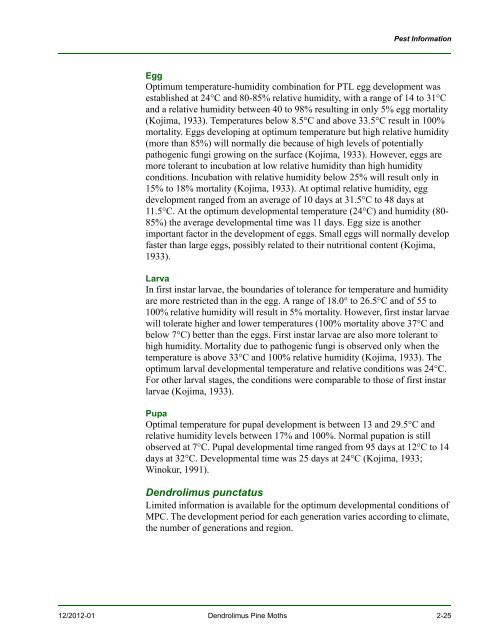New Pest Response Guidelines - aphis - US Department of Agriculture
New Pest Response Guidelines - aphis - US Department of Agriculture
New Pest Response Guidelines - aphis - US Department of Agriculture
You also want an ePaper? Increase the reach of your titles
YUMPU automatically turns print PDFs into web optimized ePapers that Google loves.
<strong>Pest</strong> Information<br />
Egg<br />
Optimum temperature-humidity combination for PTL egg development was<br />
established at 24°C and 80-85% relative humidity, with a range <strong>of</strong> 14 to 31°C<br />
and a relative humidity between 40 to 98% resulting in only 5% egg mortality<br />
(Kojima, 1933). Temperatures below 8.5°C and above 33.5°C result in 100%<br />
mortality. Eggs developing at optimum temperature but high relative humidity<br />
(more than 85%) will normally die because <strong>of</strong> high levels <strong>of</strong> potentially<br />
pathogenic fungi growing on the surface (Kojima, 1933). However, eggs are<br />
more tolerant to incubation at low relative humidity than high humidity<br />
conditions. Incubation with relative humidity below 25% will result only in<br />
15% to 18% mortality (Kojima, 1933). At optimal relative humidity, egg<br />
development ranged from an average <strong>of</strong> 10 days at 31.5°C to 48 days at<br />
11.5°C. At the optimum developmental temperature (24°C) and humidity (80-<br />
85%) the average developmental time was 11 days. Egg size is another<br />
important factor in the development <strong>of</strong> eggs. Small eggs will normally develop<br />
faster than large eggs, possibly related to their nutritional content (Kojima,<br />
1933).<br />
Larva<br />
In first instar larvae, the boundaries <strong>of</strong> tolerance for temperature and humidity<br />
are more restricted than in the egg. A range <strong>of</strong> 18.0° to 26.5°C and <strong>of</strong> 55 to<br />
100% relative humidity will result in 5% mortality. However, first instar larvae<br />
will tolerate higher and lower temperatures (100% mortality above 37°C and<br />
below 7°C) better than the eggs. First instar larvae are also more tolerant to<br />
high humidity. Mortality due to pathogenic fungi is observed only when the<br />
temperature is above 33°C and 100% relative humidity (Kojima, 1933). The<br />
optimum larval developmental temperature and relative conditions was 24°C.<br />
For other larval stages, the conditions were comparable to those <strong>of</strong> first instar<br />
larvae (Kojima, 1933).<br />
Pupa<br />
Optimal temperature for pupal development is between 13 and 29.5°C and<br />
relative humidity levels between 17% and 100%. Normal pupation is still<br />
observed at 7°C. Pupal developmental time ranged from 95 days at 12°C to 14<br />
days at 32°C. Developmental time was 25 days at 24°C (Kojima, 1933;<br />
Winokur, 1991).<br />
Dendrolimus punctatus<br />
Limited information is available for the optimum developmental conditions <strong>of</strong><br />
MPC. The development period for each generation varies according to climate,<br />
the number <strong>of</strong> generations and region.<br />
12/2012-01 Dendrolimus Pine Moths 2-25

















